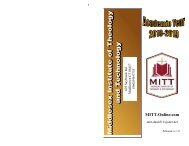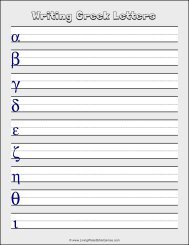50_Proofs_for the Bible
You also want an ePaper? Increase the reach of your titles
YUMPU automatically turns print PDFs into web optimized ePapers that Google loves.
<strong>50</strong><strong>Proofs</strong>NT_B.indd 1<br />
Matt.<br />
Mark<br />
Luke<br />
John<br />
Archaeological Find Description of <strong>the</strong> Find Importance of <strong>the</strong> Find<br />
11. Bethany, Where Jesus Raised<br />
Lazarus<br />
A village grew around <strong>the</strong> first-century<br />
AD tombs that once comprised Bethany’s<br />
cemetery. Since early Christian times, one<br />
tomb has been said to be that of Lazarus.<br />
By <strong>the</strong> AD 300s a church had been built over <strong>the</strong><br />
tomb of Lazarus, with steps leading down into <strong>the</strong><br />
tomb. Today visitors can still visit that ancient tomb<br />
and reflect on <strong>the</strong> great miracle Jesus per<strong>for</strong>med<br />
<strong>the</strong>re.<br />
The village of Bethany is mentioned 13 times in <strong>the</strong><br />
New Testament. Located on <strong>the</strong> east side of <strong>the</strong> Mount<br />
of Olives, only a short distance from Jerusalem, it<br />
was a favorite stopover <strong>for</strong> Jesus and <strong>the</strong> disciples<br />
when <strong>the</strong>y came to Jerusalem. It was from Bethany’s<br />
cemetery that Jesus raised Lazarus (John 11).<br />
Matt.<br />
Mark<br />
Luke<br />
Matt.<br />
Mark<br />
Luke<br />
Matt.<br />
Mark<br />
Luke<br />
John<br />
Matt.<br />
Mark<br />
Matt.<br />
Luke<br />
Matt.<br />
Mark<br />
Luke<br />
John<br />
12. The Pontius Pilate Inscription<br />
In 1961 archaeologists working at <strong>the</strong><br />
ruins of Caesarea Maritima, in Israel,<br />
found a stone slab bearing <strong>the</strong> name of<br />
Pontius Pilate, who was involved in <strong>the</strong><br />
trial of Jesus.<br />
13. Caiaphas’s Family Tomb<br />
In 1990 builders accidentally uncovered<br />
a first- century AD burial cave south of<br />
Jerusalem. Later, archaeologists investigated<br />
and found several stone boxes (called<br />
ossuaries) that contained human bones.<br />
14. Crucifixion Evidence<br />
In 1968, <strong>the</strong> bones of a young man who<br />
had been crucified during New Testament<br />
times were found in <strong>the</strong> Jerusalem area.<br />
The bones were found in a stone box<br />
bearing <strong>the</strong> name “Yehohanan.”<br />
15. Rolling Stone Tombs<br />
At several places in modern Israel <strong>the</strong>re<br />
are examples of <strong>the</strong> type of tomb in<br />
which Jesus’ body was placed after <strong>the</strong><br />
Crucifixion. Mostly cut into <strong>the</strong> sides of<br />
hills, each used a large circular stone to<br />
cover <strong>the</strong> entrance.<br />
16. Jesus’ Burial Place, <strong>the</strong> Tomb of<br />
Joseph of Arima<strong>the</strong>a<br />
Two different places in Jerusalem have<br />
been suggested as <strong>the</strong> site of <strong>the</strong> tomb<br />
from which Jesus arose. Most<br />
archaeologists believe that <strong>the</strong> Church of<br />
<strong>the</strong> Holy Sepulchre, built around AD 340,<br />
stands over <strong>the</strong> site of <strong>the</strong> tomb.<br />
17. Limestone Ossuary of James<br />
In 2002 a limestone box from <strong>the</strong> first<br />
century AD with <strong>the</strong> words “James, son of<br />
Joseph, bro<strong>the</strong>r of Jesus” inscribed on it<br />
in Aramaic was found in a private collection<br />
in Israel. Mat<strong>the</strong>w 13:55 and Mark 6:3<br />
refer to James, bro<strong>the</strong>r of Jesus.<br />
18. Herodium, King Herod’s Palace<br />
Josephus wrote that Herod was buried at<br />
his 45-acre palace, called Herodium, about<br />
two miles sou<strong>the</strong>ast of Bethlehem.<br />
19. The Madaba Mosaic Map<br />
This mosaic map of <strong>the</strong> Holy Land was<br />
made about AD 560 to serve as <strong>the</strong><br />
decorative floor of an early church located<br />
near <strong>the</strong> Dead Sea in modern Jordan.<br />
20. The Galilee Boat<br />
When drought caused <strong>the</strong> waters of <strong>the</strong><br />
Sea of Galilee to recede in 1986,<br />
residents of a village on <strong>the</strong> northwest<br />
shore found a boat buried in <strong>the</strong> mud.<br />
Later it was removed and restored.<br />
Right: Portion<br />
of <strong>the</strong> stone,<br />
bearing Pilate’s<br />
name, which<br />
commemorated<br />
his dedication<br />
of a temple to<br />
Emperor Tiberius.<br />
A 7-inch-long nail was<br />
still embedded in <strong>the</strong><br />
heel bone.<br />
Inside <strong>the</strong> tomb is a central room, called an<br />
antechamber, and as many as six to eight burial<br />
shafts. After <strong>the</strong> bodies decayed, <strong>the</strong> bones would<br />
be removed from each shaft and placed in a covered<br />
stone box (called an ossuary) in <strong>the</strong> central room. The<br />
photograph at right was taken from inside <strong>the</strong> tomb,<br />
looking out past <strong>the</strong> rolling stone and up <strong>the</strong> steps.<br />
In 2007, archaeologists unear<strong>the</strong>d<br />
several fragments of an ornately carved<br />
sarcophagus. The sarcophagus is likely<br />
<strong>the</strong> tomb of King Herod.<br />
Portion of Madaba<br />
mosaic map<br />
Left: The ossuary of<br />
Caiaphas, <strong>the</strong> priest<br />
who brought Jesus to<br />
trial. Ossuaries were<br />
used to store <strong>the</strong> bones<br />
of several generations of<br />
family members.<br />
Archaeology in and around <strong>the</strong><br />
Church of <strong>the</strong> Holy Sepulchre<br />
has revealed a rock quarry from<br />
<strong>the</strong> end of <strong>the</strong> Old Testament<br />
era. Tombs had been cut into <strong>the</strong><br />
quarry wall during <strong>the</strong> first<br />
century AD. The o<strong>the</strong>r proposed<br />
site <strong>for</strong> <strong>the</strong> tomb is <strong>the</strong> Garden<br />
Tomb, or “Gordon’s Calvary.”<br />
Palestine and Trans-Jordan<br />
The James ossuary was on display<br />
at <strong>the</strong> Royal Ontario Museum from<br />
November 15, 2002 to January 5,<br />
2003. Scholars disagree about<br />
whe<strong>the</strong>r <strong>the</strong> patina (a film that<br />
develops over centuries on stone)<br />
in <strong>the</strong> incisions of <strong>the</strong> inscriptions<br />
chemically matches <strong>the</strong> patina<br />
elsewhere on <strong>the</strong> ossuary. The<br />
history of this ossuary is in debate,<br />
as is its au<strong>the</strong>nticity.<br />
Coins and pottery found<br />
with <strong>the</strong> boat date to New<br />
Testament times. The only<br />
such boat ever found, it<br />
shows what <strong>the</strong> boats used by Jesus and <strong>the</strong><br />
disciples were like.<br />
This is <strong>the</strong> oldest appearance of Pilate’s name to be<br />
found, and it dates to <strong>the</strong> time of Jesus.<br />
Luke 3:1 says: “Now in <strong>the</strong> fifteenth year of <strong>the</strong> reign<br />
of Tiberias Caesar, Pontius Pilate being governor of<br />
Judea, and Herod being tetrarch of Galilee…”<br />
Inside <strong>the</strong> stone boxes were <strong>the</strong> bones of two infants,<br />
a child, a teenager, a woman, and a man. One box<br />
had <strong>the</strong> name “Caiaphas” on it. The man’s bones may<br />
be those of Caiaphas, <strong>the</strong> priest who brought Jesus to<br />
trial, mentioned in Mat<strong>the</strong>w 26:57 and John 18:13-14.<br />
This find shows gruesome evidence of how <strong>the</strong><br />
Romans crucified persons such as Jesus. Luke 23:33<br />
NIV says, “When <strong>the</strong>y came to <strong>the</strong> place called <strong>the</strong><br />
Skull, <strong>the</strong>re <strong>the</strong>y crucified him [Jesus], along with <strong>the</strong><br />
criminals—one on his right, <strong>the</strong> o<strong>the</strong>r on his left.”<br />
At right is a tomb with a rolling stone<br />
entrance. The curved edge of <strong>the</strong><br />
stone is on <strong>the</strong> right. Tombs were<br />
mostly cut into <strong>the</strong> sides of hills and<br />
used a large circular stone to roll in<br />
front of <strong>the</strong> entrance. Matt. 27:60;<br />
28:2; Mk. 15:46; 16:3, 4; Luke 24:2.<br />
Archaeology in <strong>the</strong> Garden Tomb area has turned up<br />
tombs of <strong>the</strong> type used during Old Testament times,<br />
with some having been reused between AD 400-600.<br />
Evidence from both locations may shed new light on<br />
<strong>the</strong> search <strong>for</strong> this all-important Christian site. Mat<strong>the</strong>w<br />
27:57-60, Mark 15:45-46, Luke 23:<strong>50</strong>-53, and John<br />
19:38-42 refer to <strong>the</strong> tomb of Joseph of Arima<strong>the</strong>a.<br />
The inscription on <strong>the</strong> box may be <strong>the</strong> oldest tangible<br />
link to Jesus. Of hundreds of <strong>the</strong>se ossuaries, only<br />
one o<strong>the</strong>r mentions a bro<strong>the</strong>r. Scholars suggest that<br />
ei<strong>the</strong>r <strong>the</strong> bro<strong>the</strong>r was responsible <strong>for</strong> <strong>the</strong> burial or was<br />
prominent. By <strong>the</strong> AD 60s when James was stoned<br />
<strong>for</strong> his devotion to Jesus as <strong>the</strong> Messiah, Jesus was<br />
prominent, and James was head of <strong>the</strong> church at<br />
Jerusalem.<br />
Mat<strong>the</strong>w 2:19-20 tells of <strong>the</strong> death of King Herod while<br />
<strong>the</strong> young child Jesus was in Egypt. Mat<strong>the</strong>w 2:1-16<br />
and Luke 1:5 also refer to Herod.<br />
This oldest map of <strong>the</strong> Holy Land<br />
yet found shows <strong>the</strong> locations of<br />
dozens of places where important<br />
Biblical events occurred.<br />
Right: The prow of a boat<br />
similar to those used by<br />
Jesus and his disciples.<br />
(Mat<strong>the</strong>w 8:23; Mark 1,<br />
3, 4, 5, 6, 8; Luke 5, 8;<br />
John 6:22)<br />
Gretchen Goldsmith Zev Radovan Zev Radovan<br />
Gretchen Goldsmith<br />
Gretchen Goldsmith<br />
Paul Fisher<br />
Zev Radovan<br />
Gretchen Goldsmith<br />
Zev Radovan<br />
www.hendricksonrose.com © 2017 Rose Publishing, Inc. <strong>Bible</strong> Reference Made<br />
Easy Permission granted to <strong>the</strong> original purchaser to print out. It is illegal to sell, email, replicate, duplicate, or post any<br />
part of this on <strong>the</strong> Internet. <strong>Bible</strong> reference charts and PowerPoints® available. Download catalog and sign up <strong>for</strong> Rose<br />
<strong>Bible</strong> e-Charts at www.hendricksonrose.com<br />
Title: <strong>50</strong> <strong>Proofs</strong> <strong>for</strong> <strong>the</strong> New Testament ISBN-13: 9781596361607




